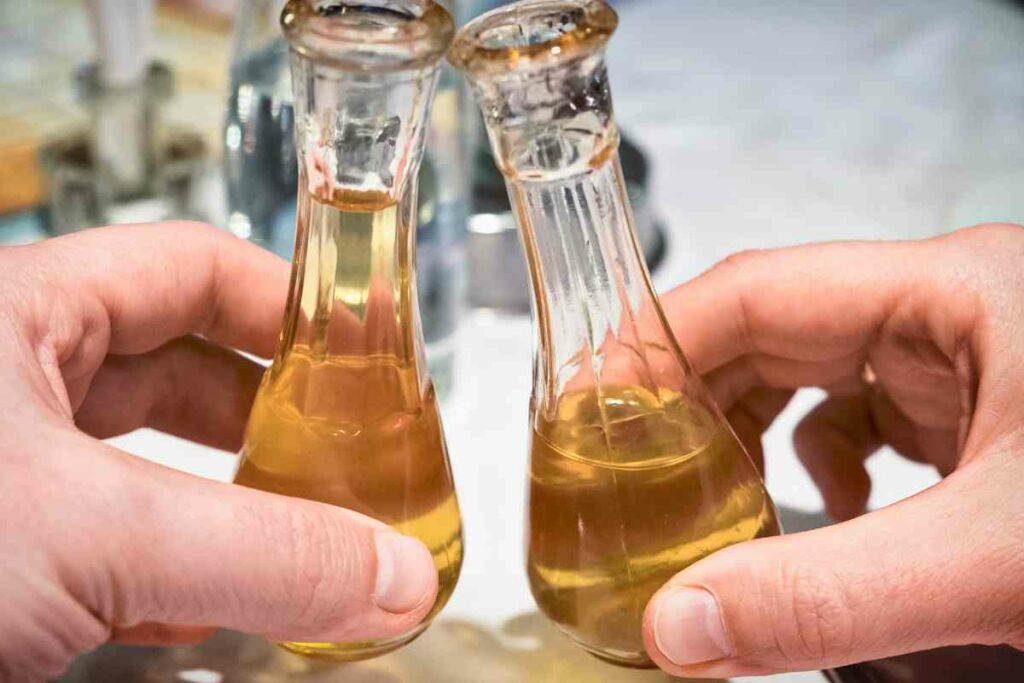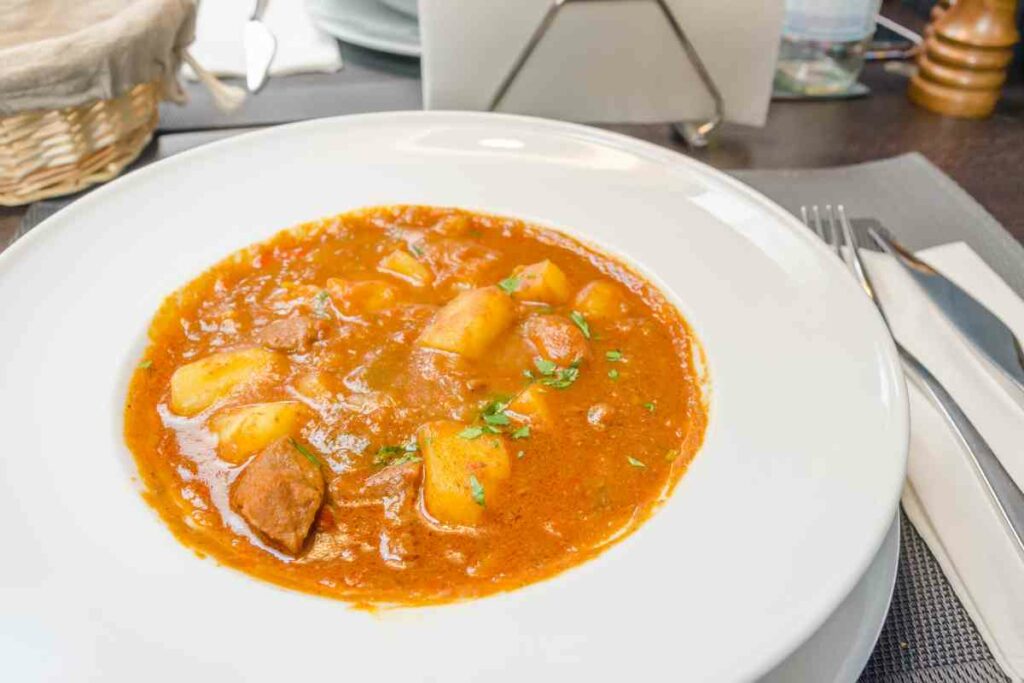I had heard so much about Serbia’s rich cultural heritage and was very excited to visit and try the incredible foods on offer!
Serbian food is full of flavor and indulgent ingredients, leaving no visitor disappointed! These traditional foods represent the country’s history using a variety of meats and spices from across the Balkans.
Let’s take a look at 6 popular Serbian foods to try on holiday.
1. Ćevapi
The delicious Serbian national dish, cevapi, is a must-try. It is one of Serbia’s most popular dishes and is made from grilled meat, either minced beef or lamb.

My guide explained it is seasoned with spices such as salt, pepper, and paprika, and then formed into small sausage-shaped portions for people to enjoy.
Ćevapi is typically served with a type of flatbread called somun (which is also delicious!). This is like pita bread, with diced onions, sour cream, ajvar, a roasted red pepper, and eggplant spread often accompanying it.
Serbians often enjoy this as a street food or as part of an informal meal with family and friends.
Also Read ?
2. Sarma
A real must-try when visiting Serbia is the delicious food, sarma.

Derived from the Turkish word “sarmak” which means “to wrap”, sarma is a traditional Serbian dish consisting of cabbage leaves stuffed with a mixture of meat, rice, and spices.
It is mostly served in the winter months and, as I was visiting in summer, it wasn’t quite as appealing. It is seen as a hearty, warming winter food.
Sarma is often enjoyed at times of celebration, including birthdays, Christmas, weddings, and other public holidays.
Sarma is usually served with:
- Mashed potatoes: This classic choice really complements the rich flavors of sarma.
- Bread: Bread in many different forms is often served with sarma, either as plain white bread or a traditional Serbian bread called lepinja.
- Ajvar: A popular roasted red pepper spread, often served as a condiment or a side dish. I found this to be a bit tangy and slightly sweet.
More on Ajvar: it is a traditional Serbian food popular throughout the Balkan region and is made from roasted red peppers, garlic, eggplant, and sometimes, chili peppers. I don’t like spicy flavors, but they can be added if you prefer a hotter taste.
These ingredients are then blended to create a thick spread that is full of flavor. Ajvar is often served as a side dish or as a condiment.
I was told the roasting process is particularly important when making ajvar. The peppers and eggplant must be roasted until their skins are charred, then they will be peeled and seeded.
Finally, the ingredients are blended with garlic, vinegar, and salt. Many Serbians enjoy this as a versatile and delicious addition to their meals.
3. Rakija
Rakija is a traditional Serbia alcoholic drink made from fermented fruit that I was eager to try.

Most commonly, plums are used but the drink can also be made from apricots, apples, pears, and grapes.
It is often drunk at times of celebration such as Christmas, birthdays, and family get-togethers. It is incredibly popular and often used in cooking, particularly in the dishes goulash and sauerkraut.
I first tried Rakija paired with some meats and cheese, and it was a tasty combination.
My guide explained the process of creating rakija includes fermenting the fruit, distilling the mixture, and aging the liquor in wooden barrels.
The alcohol content of rakija can vary, but it is usually around 40% to 65%. The variations are due to the various types of fruits used having different levels of sugar in them.
Rakija is a popular drink for tourists to try when visiting Serbia, and the friendly locals are all too happy to share their knowledge of this traditional drink.
4. Kajmak
Kajmak is a staple of Serbian cuisine and is often served at breakfast or brunch.

It is a spread made from fresh cow’s milk, often served as a side dish or condiment. The popularity of the dish is not reserved just for Serbia; many countries in the Balkan region enjoy kajmak.
I was lucky enough to visit a factory where this was being made. The process of making it is to first heat the milk to just below boiling point and allow it to cool until a layer of cream is formed on the top. This is then skimmed off and stored separately and allowed to ferment for several days.
Whilst the kajmak is fermenting it develops a slightly sour, tangy flavor, and thickens. The creamy spread can be used in many ways, but it is often enjoyed on crackers or bread.
5. Gibanica
Incredibly popular with tourists (and once I’d tried it, I knew why!) is the delightful gibanica, a traditional pastry made with many layers of phyllo dough and filled with a delicious mixture of cheese and egg.

To make gibanica, the phyllo dough is brushed with oil or melted butter, and layers of cheese and egg are created, and sometimes, meat or spinach.
I noticed it was served as a breakfast or brunch dish, and it can be enjoyed hot or cold, making it a perfect snack to grab on the go and a strong sell at outdoor food markets.
It is often paired with a mug of strong Serbian coffee, which is an important part of Serbia’s culinary culture. Gibanica is a dish that is often shared with friends as it is an easy food to create and can be eaten quickly, on the go.
6. Gulaš
Gulaš, also known as goulash, is a traditional Serbian dish of hearty, comforting vegetables, and spices, perfect for wintertime.

It’s probably the only Serbian food I had heard of before my trip! It is a delicious combination of beef, onions, paprika, and other seasonings, that creates a thick, flavorful sauce and tender meat.
Goulash is well-known across the world, making it a popular choice with tourists who instantly recognize the name, and wish to try a warm and traditional Serbian meal.
Final Thoughts on Popular Serbian Foods to Try on Holiday
Visitors to Serbia will be spoilt for choice when choosing food to enjoy on their travels.
Serbian dishes are full of history, as well as exciting, flavorful ingredients, that show the best of the incredibly diverse, Serbian cuisine. I can’t wait to go back!
- Best vs Worst French Places: A Cultural Guide for First-Time Visitors
- Master the Art of Travelling France: Insights on Must-Visit Spots
- Top three markets in France you must explore
- Essential Driving in France Kit: What Drivers Need to Stay Safe and Legal
- Top 10 Motorcycle Trips in Europe
- What Is Malta Famous For? Malta Local History and Past Events









